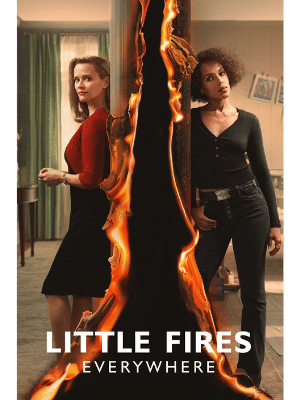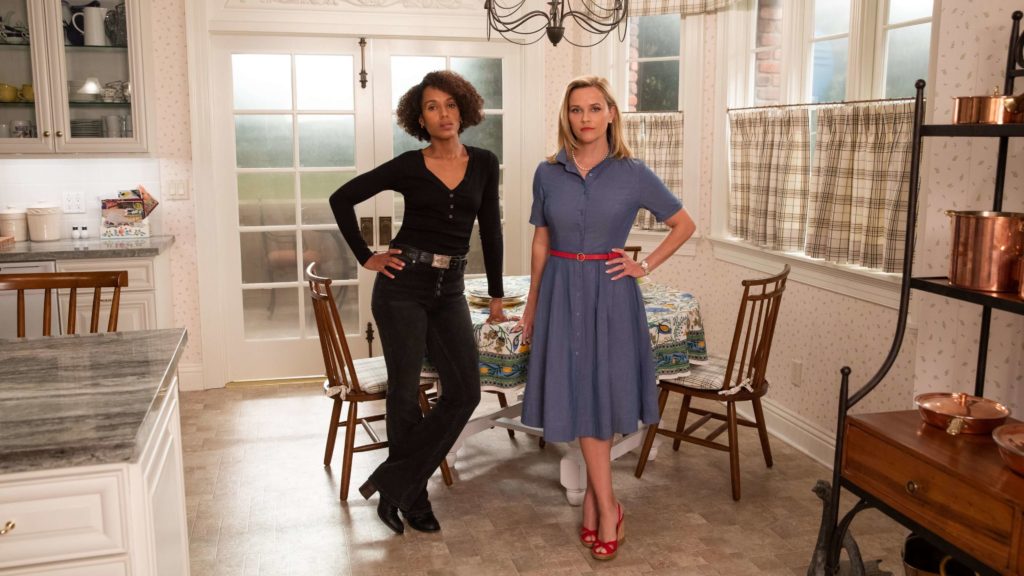Little Fires Everywhere

2020, TV-MA, 7h 43m
Table of Contents
What Is Little Fires Everywhere About?
An obscure mother/daughter move into town and become intertwined with a picture-perfect wealthy family.
Why You Should Watch Little Fires Everywhere
Little Fires Everywhere is a drama television series that was created by Liz Tigelaar and produced by Reese Witherspoon and Kerry Washington for Hulu. The series is based on the novel of the same name by Celeste Ng, and stars Witherspoon and Washington as Elena Richardson and Mia Warren, two women living in the suburbs of Cleveland, Ohio, who become embroiled in a custody battle over a Chinese-American baby.
The series begins with Elena Richardson, a successful real estate agent and mother of four, who is shocked to learn that Mia Warren, an artist and single mother, has been living in one of her rental properties without permission. Despite their initial animosity, Elena and Mia soon form a tenuous friendship, but their relationship is tested when they become involved in a custody battle over a baby girl named Lily, who was abandoned by her birth parents.
Little Fires Everywhere is a thought-provoking and emotionally charged series that explores themes of race, class, and motherhood. The series is well-written and well-acted, with standout performances from both Witherspoon and Washington. The supporting cast is also excellent, with special mention going to Rosemarie DeWitt as Linda McCullough, the adoptive mother of Lily, and Jade Pettyjohn as Lexie Richardson, Elena’s rebellious teenage daughter.
One of the standout aspects of the series is its exploration of the complex and fraught relationship between Elena and Mia. Elena is a privileged and successful white woman who has always followed the rules and expects the same from others, while Mia is a free-spirited artist who values independence and individuality. As their relationship develops, the series delves into their opposing beliefs and experiences, and the ways in which they both challenge and enrich each other’s lives.
The series also tackles some tough and timely issues, including race and class discrimination, reproductive rights, and the complexities of parenthood. The custody battle over Lily is a central plot point, and the series does an excellent job of exploring the various perspectives and motivations of the characters involved. The series also deals with issues of cultural identity and assimilation, as Lily struggles to understand and embrace her Chinese heritage.
Additionally, Little Fires Everywhere is also beautifully shot and designed. The setting of the upscale Shaker Heights suburb is a character in its own right, and the series does an excellent job of capturing its serene and seemingly perfect exterior, as well as the hidden secrets and tensions beneath the surface. The production design is also impressive, with the Richardson family’s sprawling and opulent home serving as a visual representation of their privileged lives.
Little Fires Everywhere is a emotionally charged series that explores themes of race, class, and motherhood. Give it a try, you won’t be disappointed.
The Theme of Little Fires Everywhere
One of the key themes is motherhood, which is examined from different perspectives including adoptive mothers, biological mothers, and surrogate mothers. The series also addresses issues of race and identity, exploring the experiences of African American characters in a predominantly white suburban community. Other themes explored in the series include class, privilege, and the American Dream.
The series also touches upon the complexities of relationships, both within families and between friends, and delves into the tensions that can arise when these relationships are tested. Through its exploration of these themes, Little Fires Everywhere provides a nuanced and thought-provoking examination of life in a suburban community.
Another important theme explored in the series is race and identity. The series addresses the experiences of African American characters in a predominantly white suburban community, highlighting the challenges they face and the ways in which they navigate the complexities of race and identity. The series also explores class, privilege, and the American Dream, examining the ways in which these issues can impact relationships and shape a person’s life.
The series also touches upon the complexities of relationships, both within families and between friends. It examines the tensions that can arise when these relationships are tested, and the ways in which people navigate these challenges. The series provides a nuanced and thought-provoking examination of the dynamics of human relationships, and the emotional and psychological impacts of these relationships.
In addition to these themes, Little Fires Everywhere also touches upon issues such as the nature of truth, the limits of individual freedom, and the importance of community. Through its exploration of these themes, the series provides a rich and nuanced portrait of life in a suburban community, and raises important questions about the human experience.
The Cinematography of Little Fires Everywhere
The cinematography of Little Fires Everywhere reflects the tension and conflict within the central story. The series is set in the upscale suburb of Shaker Heights, Ohio, where the placid exterior of the community is contrasted with the complex and often troubled lives of its residents. The cinematography emphasizes this contrast with its use of light and color, capturing the brightness and idealism of the community while also showing the darker, more tumultuous aspects of the characters’ lives.
The camera often lingers on the details of the setting, such as the meticulous landscaping and well-manicured lawns, to highlight the perfection that the residents of Shaker Heights strive for. Yet, as the story progresses and tensions begin to rise, the cinematography becomes more intense and frenetic, reflecting the growing chaos and uncertainty of the situation.
The Soundtrack of Little Fires Everywhere
The music was composed by Kris Bowers, and the score for the series was created to support the emotional journey of the characters and to enhance the themes explored in the show, such as motherhood, race, and identity.
Bowers combined a mix of classical music and contemporary elements to create a unique and atmospheric soundscape. The score features the use of piano, strings, and percussion, among other instruments, to create a haunting and melancholic atmosphere.
You can listen to the motion soundtrack below.
The Cast of Little Fires Everywhere
Reese Witherspoon as Elena Richardson: A successful and wealthy mom who’s obsessed with control and order, and becomes fixated on the mysterious Mia Warren and her daughter.
Kerry Washington as Mia Warren: An enigmatic artist who rents a house from the Richardsons, she is fiercely protective of her daughter and is deeply suspicious of Elena’s intentions.
Joshua Jackson as Bill Richardson: Elena’s husband, a wealthy businessman who is a loving father but also has a tendency to be controlling and inflexible.
Rosemarie DeWitt as Linda McCullough: A mom in the neighborhood who befriends Mia, but also finds herself caught up in the tension between her and Elena.
Lexi Underwood as Pearl Warren: Mia’s teenage daughter who finds herself torn between the two mothers and their very different worlds.
Jordan Elsass as Trip Richardson: Elena and Bill’s teenage son who is drawn to Pearl, leading to more conflict between their families.
Gavin Lewis as Moody Richardson: Elena and Bill’s teenage son who is more reserved and introspective, but also begins to question the dynamics of his family.

The Filmmakers of Little Fires Everywhere
- Lynn Shelton – Director
- Reese Witherspoon – Executive Producer
- Lauren Neustadter – Executive Producer
- Liz Tigelaar – Creator, Writer, Executive Producer
- Pilar Savone – Executive Producer.

Meatloaf Cordon Bleu

Inspiration
Elena’s Meatloaf
More About Little Fires Everywhere
Little Fires Everywhere was filmed in several locations in and around the city of Cleveland, Ohio, USA. The series was produced by Reese Witherspoon’s production company, Hello Sunshine, in partnership with ABC Signature Studios. The production team transformed several neighborhoods in Cleveland into the fictional suburban town of Shaker Heights, Ohio, where the series takes place. Some of the notable filming locations in Cleveland include the historic Tremont neighborhood and the University Circle area. Other additional interior scenes were filmed on soundstages in Los Angeles, California.
Many people ask if Little Fires Everywhere is based on a true story. No, Little Fires Everywhere is not based on a true story. It is an adaptation of the novel of the same name by author Celeste Ng. The book, which was published in 2017, is a work of fiction that explores themes of motherhood, race, and identity through the lens of two families in a suburban town.
The television series, which was released in 2020, follows the same storyline and characters as the novel, but adds new elements and expands on certain themes. Despite not being based on a true story, the series has been praised for its realistic portrayal of suburban life and its exploration of complex social and emotional issues.

